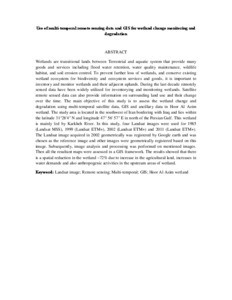Citation
Ghobadi, Yasser and Pradhan, Biswajeet and Kabiri, Keivan and Pirasteh, Saied and Mohd Shafri, Helmi Zulhaidi and Sayyad, Gholam Abbas
(2012)
Use of multi-temporal remote sensing data and GIS for wetland change monitoring and degradation.
In: 2012 IEEE Colloquium on Humanities, Science & Engineering Research (CHUSER 2012), 3-4 Dec. 2012, Kota Kinabalu, Sabah. (pp. 103-108).
Abstract
Wetlands are transitional lands between Terrestrial and aquatic system that provide many goods and services including flood water retention, water quality maintenance, wildlife habitat, and soil erosion control. To prevent further loss of wetlands, and conserve existing wetland ecosystem for biodiversity and ecosystem services and goods, it is important to inventory and monitor wetlands and their adjacent uplands. During the last decade remotely sensed data have been widely utilized for inventorying and monitoring wetlands. Satellite remote sensed data can also provide information on surrounding land use and their change over the time. The main objective of this study is to assess the wetland change and degradation using multi-temporal satellite data, GIS and ancillary data in Hoor Al Azim wetland. The study area is located in the southwest of Iran bordering with Iraq and lies within the latitude 31°28'4" N and longitude 47° 56' 57" E in north of the Persian Gulf. This wetland is mainly fed by Karkheh River. In this study, four Landsat images were used for 1985 (Landsat MSS), 1999 (Landsat ETM+), 2002 (Landsat ETM+) and 2011 (Landsat ETM+). The Landsat image acquired in 2002 geometrically was registered by Google earth and was chosen as the reference image and other images were geometrically registered based on this image. Subsequently, image analysis and processing was performed on mentioned images. Then all the resultant maps were assessed in a GIS framework. The results showed that there is a spatial reduction in the wetland ~72% due to increase in the agricultural land, increases in water demands and also anthropogenic activities in the upstream areas of wetland.
Download File
![[img]](http://psasir.upm.edu.my/68456/1.hassmallThumbnailVersion/Use%20of%20multi-temporal%20remote%20sensing%20data%20and%20GIS%20for%20wetland%20change%20monitoring%20and%20degradation.pdf)  Preview |
|
Text (Abstract)
Use of multi-temporal remote sensing data and GIS for wetland change monitoring and degradation.pdf
Download (37kB)
| Preview
|
|
Additional Metadata
Actions (login required)
 |
View Item |

